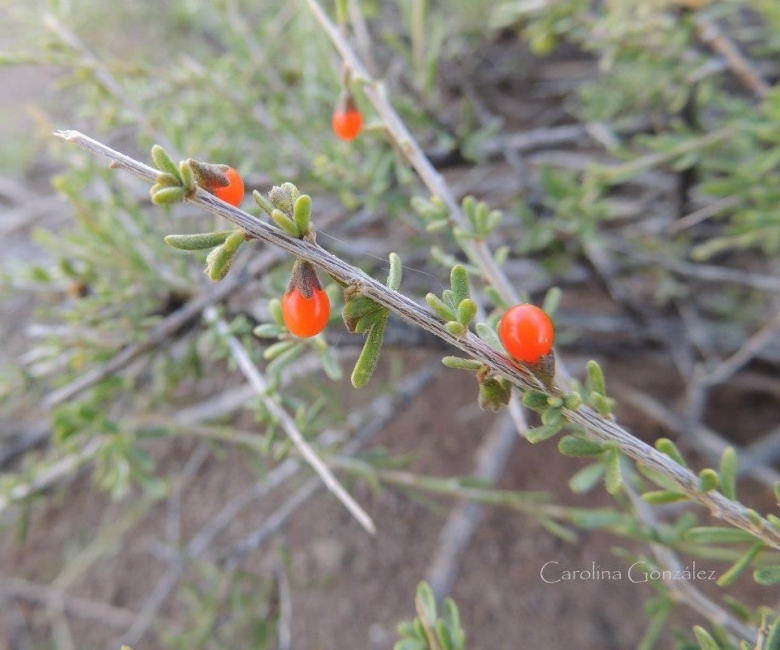
Lycium chilense Photo by: Carolina González
Origin and Habitat: Lycium chilenseSN|30952]]SN|30952]] is native to Patagonia and is widespread in Chile and Argentina (Provinces Buenos Aires, Cordoba, Chubut, Neuquen, La Pampa, La Rioja, Mendoza, Rio Negro, San Juan, San Luis, Tucuman, Aconcagua).
Altitude range: From near sea to at least 3,470 metres above sea level.
Habitat and ecology: It grows in somewhat arid level areas or slopes facing north where the drought may last 3 - 5 months. It prefers sunny places sheltered from strong winds. Precipitations 400-800 mm per annum concentrated in winter. It is endangered due to sheep overgrazing. Chances of recolonization by seeds are scarce due to the limited density of propagules in the soil and very specific requirements for germination. The berries are part of the diet of many species of birds.
Synonyms:
See all synonyms of Lycium chilense
back
Accepted name in llifle Database:Lycium chilense Miers ex BerteroMerc. Chil. 15: 693. 1829 [15 Jun 1829]Synonymy: 7
Accepted name in llifle Database:Lycium chilense var. vergarae (Phil.) ReicheAnales Univ. Chile 123: 394. 1908Synonymy: 15
back
Common Names include:
SPANISH (Español): YaullIn, Llaullín, Yaoyín, Coralillo, Mata mora
Description: Lycium chilense is an erect deciduous perennial shrub forming a dense mass of overlaying branches reaching between 0.5 and 2 m in height. It has small rather succulent, hairy leaves and produces orange-red berries. L. chilense, in the broad sense, is a widespread, variable species that has received numerous unnecessary names, representing no more than local phenotypes.
Stem: Branches thin, with thorns. Young shoots pale, more or less downy or scurfy.
Leaves: Deciduous, obovate or oblanceolate, 1 to 3.5(-5) cm long and 2-8(-12) mm wide, tapered to the base, more abruptly towards the apex, densely arranged, ciliate, rather succulent and pubescent. The larger-sized leaves are only on young vigorous sucker-growths; most of the leaves are less than 2.5 cm long.
Flowers: Hermaphrodite, solitary or in pairs in the leaf-axils, c 12 mm in diameter, funnel-shaped, deeply five-lobed (the lobes longer than the tube), white to yellowish with a purplish throat. Calyx is campanulate the triangular-pointed lobes ciliate. Tube is 1.5 to 2.5 mm long. Calyx lobes (sepals) 0.5-2.5 mm long, but usually shorter than the tube. Corolla funnel-shaped and white, whitish-yellow and whitish-violet. Stamens are hairy at the base.
Blooming season: Spring
Fruits (berries) Globular to ovoid 6-8 mm long, 4.5 mm wide, red or orange, containing 5 to 15 seeds in each carpel.
Chromosome number: 2n = 24-48
Similar species: Molecular biological studies place L. chilense as sister species to Lycium ciliatum. Both are characterized by an enlarged and ciliated base of the stamens.
Bibliography: Major references and further lectures
1) Pablo Horacio, Maseda; Jorge Hugo, Lemcoff; Mercedes, Murúa; Nora, Frayssinet; Marta Susana, Carceller. “Microcutting culture and morpho-physiological changes during acclimation in two Lycium chilense cytotypes” Biocell; 28(3); 271-277; 2004-12
2) Cabrera, A. L., R. Kiesling, F. O. Zuloaga, L. D. Bravo, H. A. Fabris, C. Ezcurra, A. Pontiroli, N. B. Deginani & R. A. Pérez-Moreau. 1983. "Parte VIII—Clethráceas a Solanáceas." 8: 1–508. In A. L. Cabrera (ed.) "Fl. Prov. Jujuy." Instituto Nacional de Tecnología Agropecuaria, Buenos Aires.
3) Bernardello, L. M. 1982. "Estudios en Lycium (Solanaceae) II. Recuentos cromosómicos en entidades Argentinas." Hickenia 1: 321–328.
4) Cabrera, A. L. 1965. "Polemoniaceae, Hydrophyllaceae, Solanaceae, Caprifoliaceae." 4(5): 96–100; 190–251; 376–380. In A. L. Cabrera (ed.) "Fl. Prov. Buenos Aires." Instituto Nacional de Tecnología Agropecuaria, Buenos Aires.
5) Levin, Rachel A. et al. 2007. "Evolutionary Relationships in Tribe Lycieae (Solanaceae)"
6) Marticorena, C. & M. Quezada. 1985. "Catálogo de la Flora Vascular de Chile." Gayana, Bot. 42: 1–157.
7) Lycium chilense Bert. In: the International Dendrology Society <http://www.beanstreesandshrubs.org/browse/lycium/lycium-chilense-bert/>
8) J.S. Miller und R.A. Levin: Lycium chilense. In: Project Lycieae <http://www3.amherst.edu/~jsmiller/LycieaeWeb/Project_Lycieae.html>
9) D.M. Spooner, L. Bohs, J. Giovannoni, R.G. Olmstead und D. Shibata (Hrsg): "Solanaceae VI: Genomics meets biodiversity. Proceedings of the Sixth International Solanaceae Conference", ISHS Acta Horticulturae 745, Juni 2007. ISBN 978-9066054271










